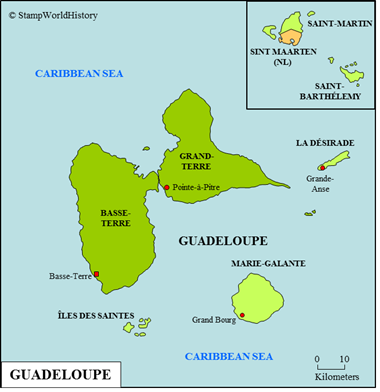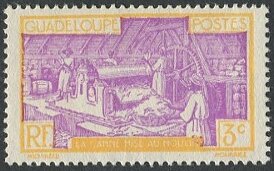
Guadeloupe
Quick reference
General issues: French colony 1884-1946, French overseas department 1946-1947
Country name on general issues: G.P.E., Guadeloupe, Guadeloupe et Dependences
Currency: 1 Franc = 100 Centimes 1884-1947
Population: 180 000 in 1900, 271 000 in 1947
Political history Guadeloupe
Guadeloupe is a group of islands located in the Caribbean and part of the Lesser Antilles – for the exact location, please refer to the map of the Caribbean. Prior to colonization the islands were inhabited the Amerindian Carib people – a people found on many of the Lesser Antilles. The first European to explore the islands was Christopher Columbus in 1493. The French established a permanent settlement on the islands in 1635. The islands were initially administered by chartered companies, but in 1674 the administration was transferred to the French crown. In the 18th and early 19th centuries, Guadeloupe was occupied by the British a number of times and was awarded to Sweden in 1813. In 1815 – effective 1816 – French sovereignty over the islands was restored. During WWII, Guadeloupe sided with the Vichy regime in France – the Vichy regime, that collaborated with Germany. The Free French, led by Charles de Gaulle, take control of Guadeloupe in 1943. When the French Empire was reorganized in 1946, the colony of Guadeloupe became a French overseas department. In 2003, Guadeloupe became a French overseas region. As such, Guadeloupe is part of the European Union and, currently, uses the Euro as its currency.
Strictly speaking Guadeloupe consists of the islands of Basse-Terre and Grand-Terre. Marie-Galante, La Désirade and the Îles des Saintes are dependencies, that – if they so wished – could apply for a status independent of Guadeloupe. Saint-Barthélemy and the French part of Saint-Martin – also part of the Lesser Antilles, but located further to the north – were dependencies of Guadeloupe until they separated from Guadeloupe in 2007 to become French overseas collectivities.
From the first permanent settlement, Guadeloupe was developed as a plantations colony – the most important cash crop being sugar cane. To man the plantations, slaves were brought to the islands – slaves that would soon outnumber the population of European descent. Currently tourism is the mainstay of the Guadeloupe economy. With 80%, blacks and people of mixed black and white descent form the majority of the population. Whites of European – mostly French – descent account for 10% of the population.
Postal history Guadeloupe
The first stamps used in Guadeloupe are the general issues of France from 1851 and the general issues for the French colonies from 1859. The first stamps for specific use in Guadeloupe appear in 1884 – overprints on the issues for the French colonies reading ‘G.D.P.’ and a new face value. More provisionals follow in 1889, 1890 and 1891. The 1891 issues – overprints reading ‘Guadeloupe’ on the general issues for the French colonies – show a lot of varieties. Not only inverted and double overprints, but also errors in the spelling of the country’s name. Thus, one may find: Gnadeloupe, Guadbloupe, Guadelonpe and Guadelouep. The first definitives are issued in 1892 – stamps of the common ‘Navigation & Commerce’ design, inscribed ‘Guadeloupe et Dependances’. In the classical period several large sets of pictorials are issued. Furthermore, Guadeloupe takes part in several of the ‘Grand Series'[1]Omnibus issues for the French colonies. In 1941, stamps were prepared by the Vichy regime in France for use in Guadeloupe. As these were never put on sale, only the mint versions are listed. The last stamps for Guadeloupe are issued in 1947. Since then, Guadeloupe has used the stamps of metropolitan France. The stamps of Guadeloupe were used in Guadeloupe proper and in the dependencies, including Saint-Barthélemy and Saint-Martin.
Album pages
← Previous page: GrenadaNext page: Guatemala →



